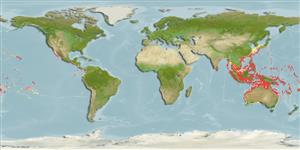Common names from other countries
Classification / Names / Names
Nomi Comuni | Sinonimi | Catalog of Fishes (gen., sp.) | ITIS | CoL | WoRMS
Environment: milieu / climate zone / depth range / distribution range
Ecologia
; distribuzione batimetrica 0 - 69 m (Ref. 8252). Tropical
Indo-Pacific: from Myanmar to Tonga; north to the Philippines and possible also Hawaii, and south to Queensland.
Length at first maturity / Size / Peso / Age
Maturity: Lm ? range ? - ? cm Max length : 9.5 cm SHL maschio/sesso non determinato; (Ref. 348); common length : 7.0 cm SHL maschio/sesso non determinato; (Ref. 348)
In sandy-coral bottoms, fully buried to completely exposed, in shallow water (Ref. 348).
Life cycle and mating behavior
Maturità | Riproduzione | Deposizione | Uova | Fecundity | Larve
Members of the class Bivalvia are mostly gonochoric, some are protandric hermaphrodites. Life cycle: Embryos develop into free-swimming trocophore larvae, succeeded by the bivalve veliger, resembling a miniature clam.
Glover, E.A. and J.D. Taylor. 2007. (Ref. 8252)
IUCN Red List Status (Ref. 130435)
CITES status (Ref. 108899)
Not Evaluated
Not Evaluated
Human uses
Pesca: commerciale
| FishSource |
Strumenti
Informazioni ulteriori
Age/SizeAccrescimentoLength-weightLength-lengthMorfologiaLarveAbbondanza
Fonti Internet
Estimates based on models
Preferred temperature
(Ref.
115969): 24.6 - 29, mean 28.1 (based on 1258 cells).
Vulnerability
Low vulnerability (10 of 100).
Price category
Unknown.
